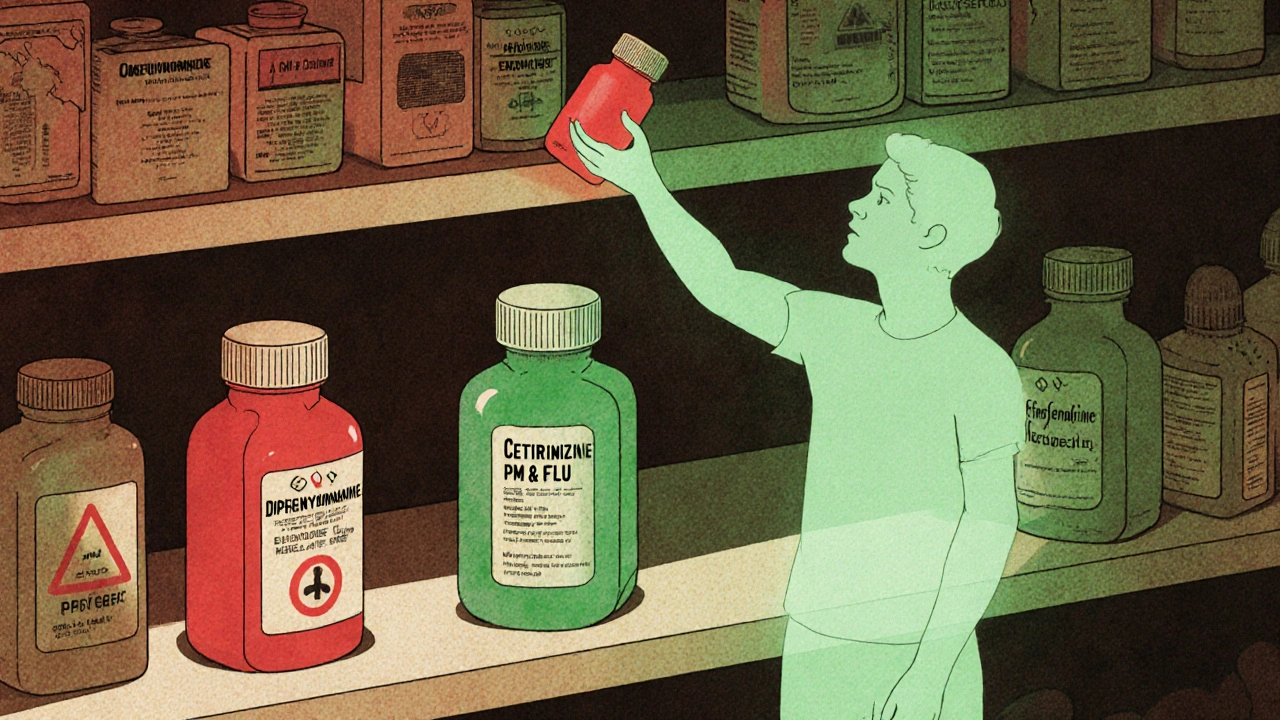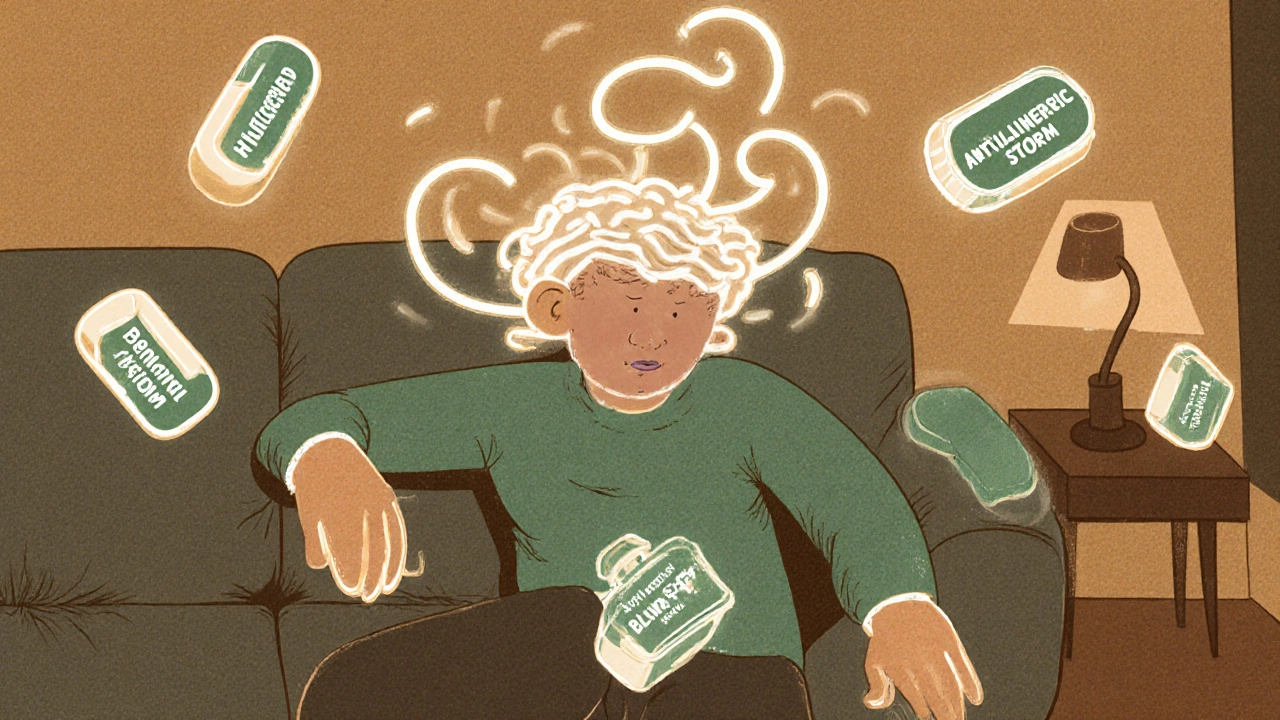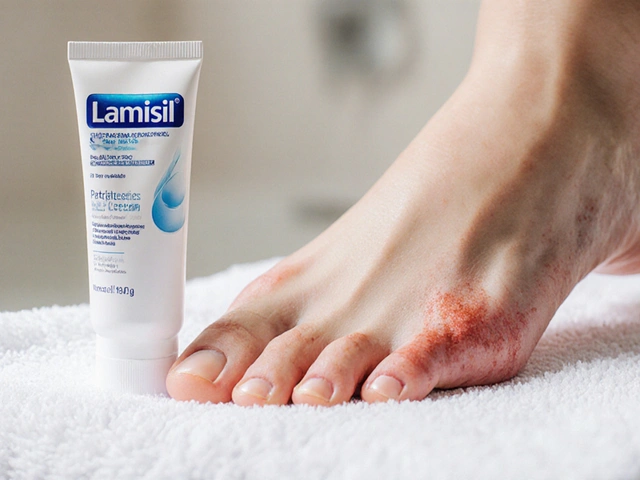Anticholinergic Medication Checker
Check if your over-the-counter or prescription medication contains first-generation antihistamines. These can cause dangerous drowsiness, cognitive decline, and other anticholinergic effects.
Important Note
First-generation antihistamines (diphenhydramine, chlorpheniramine, promethazine) are found in many cold remedies, sleep aids, and allergy medications. Even if you don't recognize them by name, check for ingredients like "PM" or "Benadryl."
Enter a medication name above to see if it contains first-generation antihistamines and their associated risks.
Why First-Generation Antihistamines Make You So Sleepy
You grab a bottle of Benadryl for your itchy rash or runny nose. Within an hour, you’re nodding off on the couch. You think, That’s the point-it’s helping you sleep. But what if that sleepiness isn’t just a side effect? What if it’s a red flag for something deeper?
First-generation antihistamines like diphenhydramine, chlorpheniramine, and promethazine don’t just block histamine. They crash into your brain like a truck. These drugs were designed in the 1940s to fight allergies, but they weren’t built with safety in mind. They’re small, oily molecules that slip past the blood-brain barrier easily. Once inside, they bind to H1 receptors in your brain and shut down the wakefulness signals. The result? Severe drowsiness that can last 6 to 18 hours-even after you think it’s worn off.
More Than Just Sleepiness: The Hidden Anticholinergic Toll
Drowsiness is the obvious problem. But there’s a quieter, more dangerous side effect hiding in plain sight: anticholinergic effects.
These drugs don’t just target histamine. They also bind tightly to muscarinic receptors-those same receptors that control saliva, bladder function, vision, and memory. That’s why people on these meds often report dry mouth so bad they need artificial saliva. Or blurred vision that makes reading the label on a pill bottle impossible. Or trouble peeing, especially in older men with enlarged prostates. These aren’t minor inconveniences. They’re signs your nervous system is being thrown off balance.
For older adults, this is especially dangerous. The American Geriatrics Society calls first-generation antihistamines potentially inappropriate for people over 65. Why? Because chronic use raises the risk of cognitive decline by 54%. That’s not a small number. It’s a clear link between taking something for allergies and losing your memory over time. Studies show that even low doses, taken nightly for sleep, can cause confusion the next morning that lasts hours. It’s not just feeling groggy-it’s brain fog that mimics early dementia.
How They Compare to Second-Generation Antihistamines
Think of first-generation antihistamines as the old-school tools that still work-but come with a heavy price. Second-generation ones like cetirizine (Zyrtec) and loratadine (Claritin) are the modern upgrade. They’re bulkier, less oily, and designed to stay out of the brain. Their brain concentrations are 90% lower than diphenhydramine’s. That’s why you can take Zyrtec at 8 a.m. and drive to work without feeling like you’re drunk.
Here’s the real difference:
- Diphenhydramine (Benadryl): Brain concentration of 15-25 ng/mL after one dose. Driving impairment score of 0.8 (out of 1.0). Effects last up to 18 hours.
- Cetirizine (Zyrtec): Brain concentration under 1 ng/mL. Driving impairment score of 0.2. No next-day grogginess in most people.
First-gen drugs are 30-50% more likely to occupy brain receptors. That’s why they’re still used for motion sickness and acute insomnia-they work fast and hard. But for everyday allergies? There’s no reason to risk it.

Who’s Still Taking Them-and Why
Despite the risks, first-generation antihistamines are everywhere. In 2022, 45 million Americans used them. Why? Price. A bottle of 24 diphenhydramine tablets costs $5. The same number of Zyrtec tablets? $15. For people on tight budgets, the math is simple.
They’re also still sold as sleep aids. Many older adults take 12.5 mg at night because they’ve been told it’s “natural.” But here’s the catch: 42% of them report morning confusion that lasts 3-4 hours. That’s not restful sleep. That’s chemical sedation with a hangover.
And then there’s the misinformation. OTC packaging rarely warns you that these drugs impair your reaction time for half a day. A 2022 JAMA study found 45% of users had no idea their drowsiness could last beyond bedtime. That’s why emergency rooms see so many cases of drowsy driving-35% of them involve first-gen antihistamines.
When They Might Still Make Sense
Are first-generation antihistamines always bad? No. There are a few cases where their brain-penetrating power is actually useful.
- Motion sickness: Promethazine works better than any second-gen drug for nausea on boats or planes. It’s why cruise ships still stock it.
- Short-term insomnia: If you’re dealing with a single night of severe anxiety or jet lag, diphenhydramine can knock you out fast. But don’t use it every night.
- Acute allergic reactions: In emergency cases-like sudden hives or swelling-Benadryl’s fast onset (15-30 minutes) can be lifesaving.
But these are exceptions. Not the rule. If you’re using it daily for allergies or sleep, you’re trading safety for convenience.

What You Should Do Instead
If you’re on a first-generation antihistamine and feel tired all the time, you’re not imagining it. You’re not weak. You’re just taking a drug that’s designed to make you sleepy.
Here’s what to do:
- Switch to a second-generation antihistamine: Cetirizine, loratadine, fexofenadine (Allegra), or desloratadine. They work just as well for allergies-with none of the brain fog.
- Don’t mix with alcohol: Alcohol boosts brain penetration by 40-60%. That’s like doubling your dose.
- Check your other meds: Many antidepressants, stomach meds, and painkillers also have anticholinergic effects. Taking them with Benadryl? You’re stacking the risk.
- Ask your doctor about alternatives: For sleep, melatonin or cognitive behavioral therapy for insomnia (CBT-I) are safer long-term options.
- Read labels: Benadryl is obvious. But so is “PM” in cold medicines. NyQuil, Excedrin PM, and even some sleep aids contain diphenhydramine or doxylamine (a close cousin).
The Future: Are These Drugs Disappearing?
Regulators are waking up. The UK banned promethazine for under-16s in 2022. The FDA is considering similar restrictions on diphenhydramine after pediatric ER visits jumped 27% between 2018 and 2022. New research is even looking at modified versions that keep the allergy-fighting power but can’t cross into the brain.
By 2030, experts predict OTC sales of first-gen antihistamines will drop 15-20% as cheaper second-gen options become more common. But they won’t vanish. They’re too cheap, too available, and too deeply embedded in our culture as “sleep aids” and “allergy cures.”
The real change will come from awareness. If you know these drugs can fog your brain for half a day, you’ll think twice before reaching for them. And that’s the first step toward safer choices.
What to Remember
First-generation antihistamines aren’t evil. But they’re not harmless either. They’re powerful drugs with a narrow benefit window and a wide range of risks. If you’re using them for daily allergies or sleep, you’re paying a steep price in cognitive function, safety, and long-term brain health.
There’s a better way. Safer, just-as-effective options exist. You don’t need to feel dazed to manage your allergies. And you don’t need to risk memory loss to get a good night’s sleep.
Ask yourself: Is this helping me-or just masking the problem with a chemical sedative?
Can first-generation antihistamines cause dementia?
Long-term use of first-generation antihistamines like diphenhydramine is linked to a 54% higher risk of cognitive decline and dementia, especially in people over 65. This is due to their strong anticholinergic effects, which interfere with acetylcholine-a brain chemical critical for memory and learning. The risk builds up over time, even with low daily doses. Stopping these medications may help slow further decline.
How long does drowsiness from Benadryl last?
Drowsiness from diphenhydramine typically starts within 30 minutes and peaks around 1-2 hours after taking it. For most people, it lasts 4-6 hours, but cognitive impairment can persist for up to 18 hours. Driving, decision-making, and reaction times remain impaired well into the next day, even if you feel awake. This is why the FDA warns against operating machinery for at least 6 hours after use.
Is it safe to take Benadryl every night for sleep?
No. Taking Benadryl nightly for sleep is not safe long-term. It leads to tolerance-meaning you need more to get the same effect-and increases your risk of cognitive decline, urinary problems, dry mouth, and next-day confusion. It also disrupts natural sleep architecture, reducing deep and REM sleep. For chronic insomnia, safer options include melatonin, CBT-I, or prescription sleep aids under medical supervision.
Do second-generation antihistamines cause drowsiness?
Most second-generation antihistamines like cetirizine, loratadine, and fexofenadine cause little to no drowsiness in most people. However, about 10-15% of users may still feel slightly tired, especially at higher doses or if they’re sensitive. Cetirizine is the most likely to cause mild sleepiness among second-gen options, but it’s still far less sedating than diphenhydramine.
What are the signs of anticholinergic toxicity?
Signs include dry mouth, blurred vision, trouble urinating, constipation, rapid heartbeat, confusion, memory problems, hallucinations, and flushed skin. In older adults, these symptoms can be mistaken for dementia or depression. If you’re taking a first-generation antihistamine and notice any of these, talk to your doctor immediately. Stopping the drug often reverses the symptoms.






Bradley Mulliner
November 3, 2025 AT 05:41Let me get this straight-you’re telling me people are still using Benadryl like it’s a nightly ritual? Like it’s herbal tea or something? This isn’t ‘natural sleep.’ This is chemical sedation wrapped in a $5 bottle of denial. You’re not sleeping-you’re being drugged into submission, and then you wonder why your brain feels like wet cardboard the next day. Wake up. The science is clear. You’re not ‘toughing it out.’ You’re just slowly eroding your hippocampus. And no, ‘I’ve been doing it for years’ doesn’t make it safe-it makes you a walking case study.
Rahul hossain
November 4, 2025 AT 05:25One must observe with sober eyes: the modern pharmacopeia has become a carnival of convenience. First-generation antihistamines? They are the equivalent of using a sledgehammer to crack a walnut-brutal, inefficient, and deeply unrefined. One cannot help but feel pity for those who mistake pharmacological brute force for therapeutic wisdom. The second-generation agents are not merely ‘better’-they are the elegant solution, the quiet revolution whispered in molecular form. And yet, the masses cling to the old ways, as if nostalgia were a valid clinical metric.
Reginald Maarten
November 5, 2025 AT 00:45Actually, the 54% increased risk of cognitive decline is from observational studies-correlation ≠ causation. Many of those studies don’t control for confounders like baseline cognitive health, polypharmacy, or socioeconomic factors. Also, cetirizine isn’t ‘non-sedating’-it’s just less sedating than diphenhydramine. 10–15% of users still report drowsiness, and that’s not trivial. And let’s not forget: doxylamine, which is in NyQuil, is even more potent than diphenhydramine. So if you’re switching to Zyrtec but still taking ‘PM’ meds, you’re just swapping one problem for another. The real issue isn’t the drug class-it’s the lack of patient education. Also, ‘anticholinergic burden’ is a real concept, but it’s cumulative across all meds-not just antihistamines.
Jonathan Debo
November 5, 2025 AT 14:50It’s astonishing-absolutely astonishing-that anyone still considers diphenhydramine a viable option for anything beyond acute, life-threatening allergic reactions. The fact that it’s OTC is a public health scandal. The FDA’s inaction is criminal negligence. And the packaging? It’s a masterpiece of deceptive marketing: ‘Helps you sleep’-not ‘causes chemical sedation that impairs your prefrontal cortex for 18 hours.’ The word ‘sleep’ is used to obscure the fact that it’s not sleep-it’s a pharmacologically induced coma with a side of anticholinergic toxicity. And don’t get me started on the elderly: 42% reporting morning confusion? That’s not ‘feeling groggy.’ That’s functional impairment. You wouldn’t let someone drive after three shots of whiskey-why are you letting them take a drug that does the same thing? It’s not just irresponsible-it’s unethical.
Robin Annison
November 6, 2025 AT 19:53I think what’s really missing here is the emotional weight of this issue. People aren’t taking Benadryl because they’re dumb-they’re taking it because they’re tired. Tired of insomnia. Tired of allergies ruining their lives. Tired of being told to ‘just sleep better’ or ‘try yoga’ when they’re already exhausted. There’s a loneliness in that. We talk about cognitive decline like it’s an abstract risk, but for someone who’s 70 and can’t remember where they put their keys, the fear is real. Maybe the answer isn’t just ‘switch to Zyrtec’-maybe it’s better access to CBT-I, affordable healthcare, and real conversations with doctors who don’t rush through appointments. The drug is a symptom, not the disease.
Abigail Jubb
November 8, 2025 AT 14:46OMG. I just realized I’ve been taking ZzzQuil every night for three years. Like… I thought it was ‘natural’ because it’s OTC. I’ve been having these weird ‘brain fog’ days where I forget people’s names, and I thought it was just aging. But now I’m sobbing. I’m 62. I just lost my husband last year. I thought this was helping me cope. I didn’t know I was slowly erasing my mind. I’m going to stop tonight. I’m going to call my doctor. I need help. Thank you for this post. I didn’t know I was poisoning myself.
George Clark-Roden
November 9, 2025 AT 05:13There’s something deeply human about this. We reach for the quick fix-not because we’re lazy, but because we’re worn down. The body says: ‘I need rest.’ The mind says: ‘I can’t sleep.’ And then, in the dark, we swallow the little white pill that promises peace. But what it delivers is a shadow of rest-a hollow echo of sleep. And then we wake up, not refreshed, but haunted by the fog. We don’t realize it’s the drug. We think it’s us. We think we’re broken. But we’re not. We’re just caught in a system that sells sedation as solution. The real tragedy? The alternatives exist. But they cost time. They cost patience. They cost someone listening. And sometimes, that’s harder to find than a bottle of Benadryl.
Hope NewYork
November 10, 2025 AT 14:44